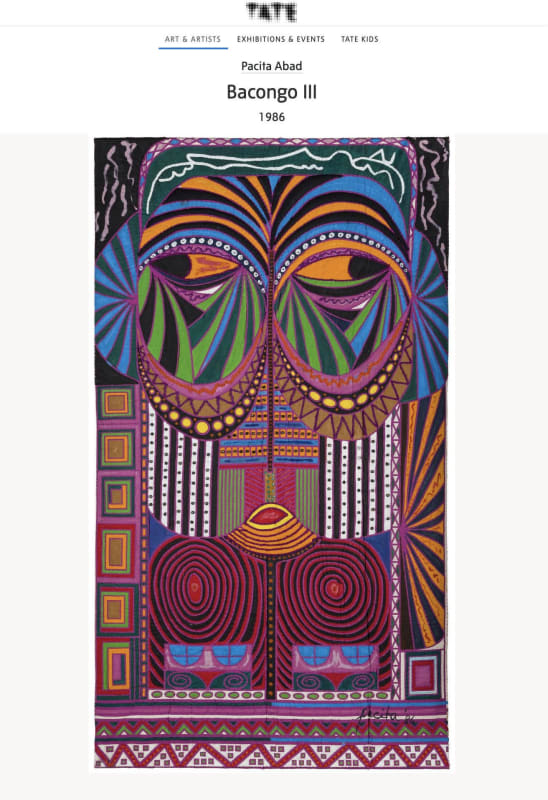Summary by Clara Kim, Daskalopoulos Senior Curator, International Art at Tate Modern
This is one of a group of three quilted canvas works in Tate’s collection by the Filipino artist Pacita Abad (see also Bacongo III 1986, and Bacongo VI 1986). They are part of a series that Abad began in the late 1970s. Referring to them as trapuntos, from the Italian word for embroidery or quilt, these works are the artist’s responses to the cultural traditions that she encountered during her travels in Asia, Africa and Latin America, although they also refer to vernacular traditions of sewing – a traditional part of family education in the Philippines. They were made using large pieces of canvas onto which the artist stitched forms, creating a three-dimensional effect by stuffing the canvases and transforming their surface with paint, shells, buttons, beads, mirrors and other objects collected on her travels. Their decorated surfaces integrate a range of patterning techniques to create semi-figurative forms with what look like large eyes set in stylised, mask-like faces. Abad dispensed with stretcher bars and hung these works directly on the wall or from the ceiling and this, combined with the distinctive technique, transformed the relatively flat surface of a picture into something more multi-dimensional. The portability of the trapunto form can be said to resonate with the peripatetic aspect of a migrant existence as experienced by the artist, being an object that can theoretically be rolled up and more easily transported than a stretched painting.
Inspired by her travels and interest in responding to cultural traditions in Indonesia, Bangladesh, Sudan, Philippines and elsewhere, Abad’s aim in her work was to connect with the world through a vibrant formal language that integrated her interest in traditional art forms such as batik painting in Indonesia, ink-brush painting in Korea, tie-dye in Africa and macramé in Papua New Guinea, all within a language of abstraction and figuration. Dismayed by Western-centric artistic styles while studying at the Corcoran School of Art in Washington D.C. in the mid-1970s, Abad became interested in social realism and also encountered works by the Mexican muralists Diego Rivera (1886–1957), David Siqueiros (1896–1974) and José Clemente Orozco (1883–1949) during a trip to Mexico in 1986. She sought to rejuvenate different artistic traditions and indigenous forms in order to respond to the social and political realities of communities she encountered, in particular refugees, immigrants and others at the margins of society. Of the artist’s motivations, the curators Joselina Cruz and Pio Abad have written:
The narratives which Abad painted to speak about contemporary art and culture in the Philippines were often located elsewhere. Immigration for her was an important issue but more so when she observed the US becoming more disturbed with a changing ‘multiethnic society of legal and illegal immigrants’. Her work was ‘multi-ethnic’ as it brought together experiences across cultures – Bangladesh to Sudan, Sudan to Jakarta, Jakarta to Boston, Washington DC to Manila, Yemen to Singapore – her creative trajectory dictated by her constantly shifting location … Importantly, she also referenced and painted a multiplicity of conditions which were not of her lived experience, but which, at the same time was the story of her life.
(Joselina Cruz and Pio Abad, in Museum of Contemporary Art and Design 2018, unpaginated.)
Two of the embroidered tapestries in Tate’s collection are from a series entitled Bacongo, referring to the Bantu ethnic group in Central Africa. The third, European Mask, speaks to Abad’s reversal of the co-opting of so-called primitive art by Western artists within the history of modern art. European Mask was installed as part of the work Metro Center Mural: Six Masks from Six Continents at a metro station in Washington D.C. from 1990–3. It was also included in the solo exhibition of the artist’s work at the Museum of Contemporary Art and Design in Manila in 2018, which focused on her trapunto works. The American artist Faith Ringgold (born 1930), who has also worked with quilted canvases, was taken by Abad’s trapunto works and authored a text on her work in the volume Fresh Talk/Daring Gazes: Conversations on Asian American Art edited by Elaine H. Kim, Margo Machida and Sharon Mizota (2003).
Further reading
Margo Machida (ed.), Asia/America: Identities in Contemporary Asian American Art, exhibition catalogue, The Asia Society Galleries, New York 1994.
Ian Findlay-Brown, Pacita Abad: Exploring the Spirit, exhibition catalogue, National Gallery of Indonesia, Jakarta 1996.
Joselina Cruz and Pio Abad, Pacita Abad: A Million Things to Say, exhibition brochure, Museum of Contemporary Art and Design, Manila 2018.
Clara Kim
June 2018
